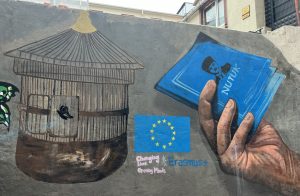You’ll see him here, you’ll see him there, you’ll see him just about everywhere. Those busts and statues gracing the main square in every town and village are all reminders of Turkey’s national hero, Mustafa Kemal, later named Atatürk (1881-1938).
Every Turkish schoolchild learns Atatürk’s life story off by heart and on 10 November every year the whole country grinds to a standstill on the stroke of 9.05 am for a minute’s silence to commemorate his death.
Atatürk’s life and death
Mustafa Kemal was born in 1881, the son of Ali Riza Efendi and Zübeyde Hanım. His birthplace was Salonica (the modern Thessaloniki) in Greece, which was then part of the Ottoman Empire, and visitors to that town can visit the three-storey house where he grew up on production of their passport. To make things easier for those who don’t want to travel all the way to Greece, there are also two replicas of the house in Turkey. The first of them is in the Atatürk Forest Farm (Orman Çiftliği) in Ankara, the second in Kutlukent, seven kilometres east of Samsun on the Black Sea.
He first rose to prominence as a military leader in the Gallipoli campaign near Çanakkale during World War I. It was at Gallipoli that Atatürk helped repulse the ANZAC troops as they came ashore in what is now Anzac Cove in 1915, giving his men the famous command: “I am not ordering you to attack. I am ordering you to die.”
Later during the same campaign, he was fortunate to escape death when his pocket watch deflected a bullet at Conkbayırı (Chunuk Bair) where he had established his command post. Today, visitors to the battlefields can read his moving words to the mothers of the fallen ANZACS: “To us there is no difference between the Johnnies and the Mehmets…”
In the immediate aftermath of the defeat of the Ottoman Empire in World War I, Mustafa Kemal and a band of comrades started to make preparations to free Turkey from the foreign troops that were occupying it. On May 19, 1919 they arrived by boat in Samsun to launch the War of Independence. Today visitors to the town can walk along a boardwalk called the Kurtuluş Yolu (Liberation Way) running down to the sea that serves as a reminder of this momentous event and visit a replica of the steamship Bandırma on which the men arrived in Samsun.
From Samsun, Mustafa Kemal headed for the lovely inland town of Amasya to hold the first of a series of planning meetings on 21 June. In Sivas, the building where the rebels gathered on Sept. 4 now houses the Ataturk Congress Museum with their photos resting on the old-fashioned wooden school desks that were used during the meeting.
The Turkish War of Independence formally ended on 24 July 1923 and Atatürk became the country’s first president on 29 October 1923, a position he held until his death.
In October 1938, Atatürk was dining in İstanbul with friends on the presidential yacht, Savarona, when he was taken ill. He was conveyed to the nearby Dolmabahçe Palace, where he eventually died on 10 November. Since then, every clock in the palace has been stopped at 9:05, the precise moment of his death, as recorded rather movingly in pencil on the desk diary of Celal Bayar, later the country’s third president, which is on display in the Second Congress Building in Ankara. Every visit to Dolmabahçe Palace should include a visit to the room in which Atatürk died and where his unexpectedly narrow bed is draped with the Turkish flag.
Atatürk’s main legal changes
1923 Proclamation of Turkish Republic to replace Ottoman Empire. Capital moved to Ankara.
1924 New constitution adopted. Abolition of caliphate.
1925 Polygamy abolished. Dervish tekkes (lodges) closed down. Men obliged to abandon fezes in favour of şapkas, Western-style hats with brims.
1926 Introduction of Western-style legal code. Civil marriage replaced religious version.
1928 Islam ceased to be state religion. Latin alphabet replaced Arabic one.
1930 Constantinople officially became İstanbul. Other town names Turkified.
1934 Women won right to vote and sit in parliament.
1935 All Turks required to adopt a surname. Ayasofya turned into a museum.
Atatürk today
As the years roll by, so Atatürk becomes even more of a hero as long-standing Kemalists, supporters of a secular way of life, fight to keep the flame alive. There are even laws against insulting Atatürk. Inevitably the most fervently religious Turks can get heartily sick of him.
Atatürk was a great orator and many of his speeches and pithy sayings still adorn public buildings. Look out in particular for Ne Mutlu Türküm Diyene (How Happy is He Who Can Call Himself a Turk) which goes down like a lead balloon in Kurdish parts of the country.
Other favourites include Türk, Oğun, Çalış, Güven (Turk, Be Proud, Work Hard and Be Confident) and Yurtta Sulh, Cihanda Sulh (Peace at Home, Peace in the World in Old Turkish).
Almost all Turkish towns will have a main road called Atatürk Caddesi or Ataturk Bulvarı and almost any house ever visited by Atatürk will now be a museum, usually showcasing photographs of his life alongside some of his personal possessions.
Turkish businesses are all meant to display a picture of Atatürk and the one they choose often says a lot about their politics – those who pick the version of Atatürk wearing an opera cape, for example, are not likely to be religiously inclined. Over public holidays pictures of Atatürk drape public buildings alongside the flags. On the quiet, some secularists buy Turkish flags adorned with pictures of their hero to display.
Read more about how to follow in Atatürk’s footsetps: On the Atatürk Trail



